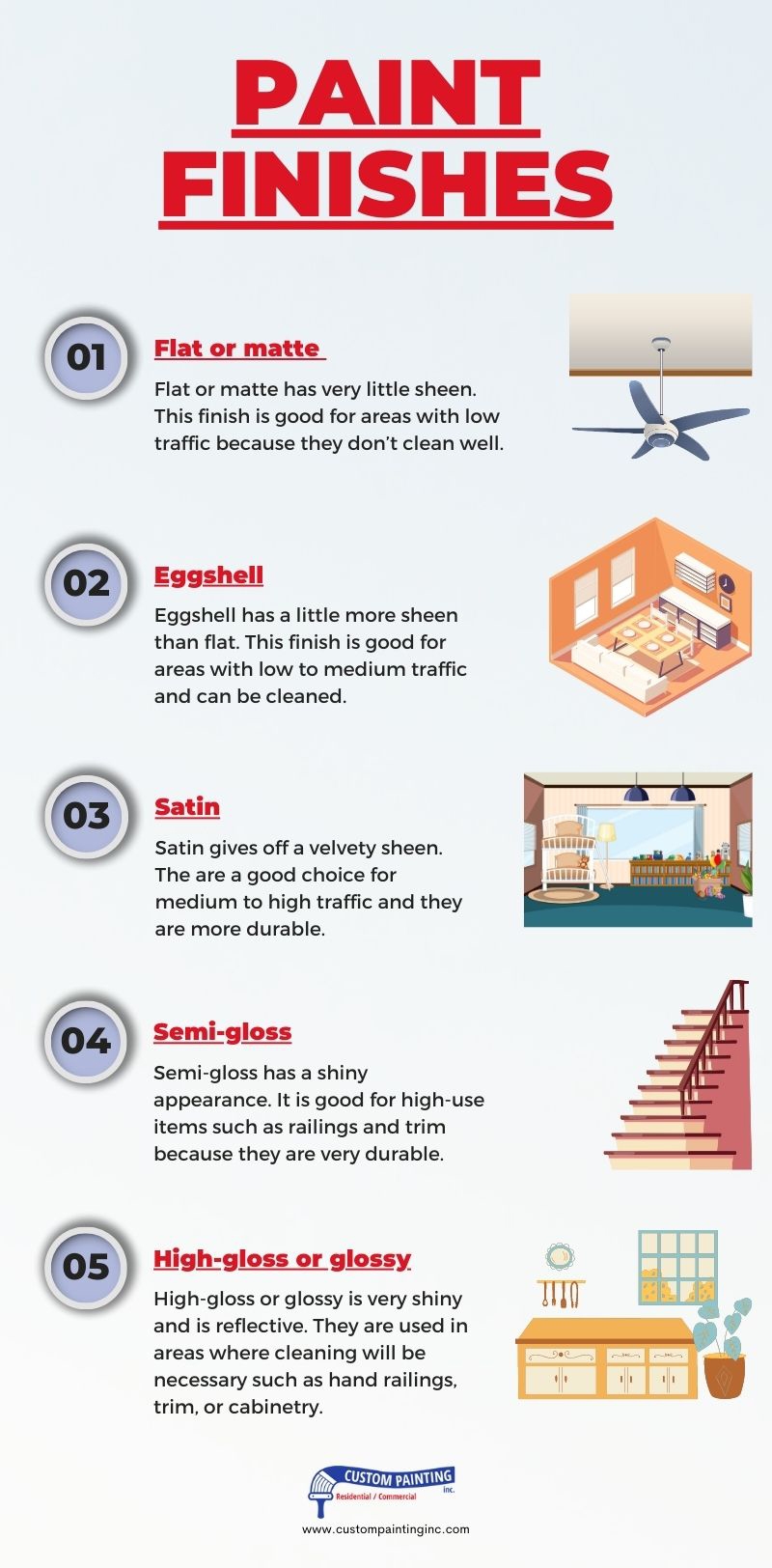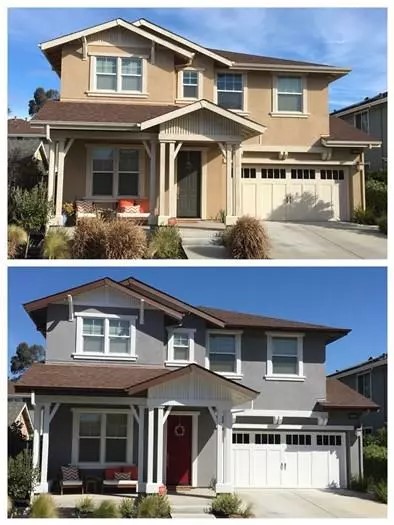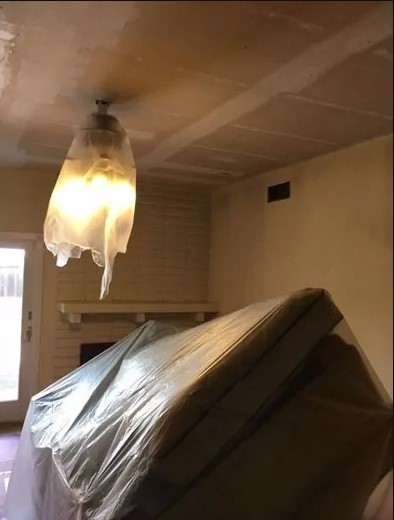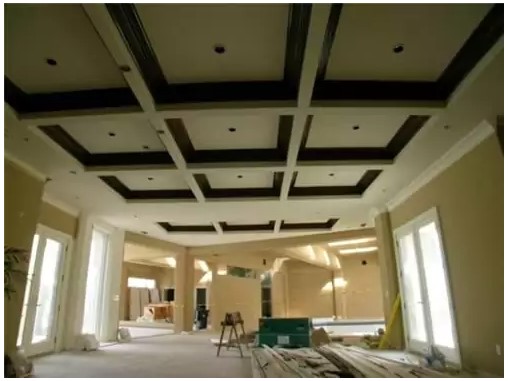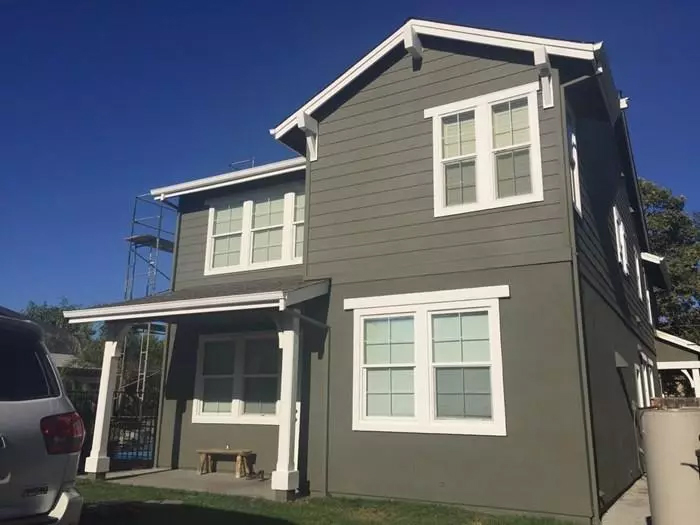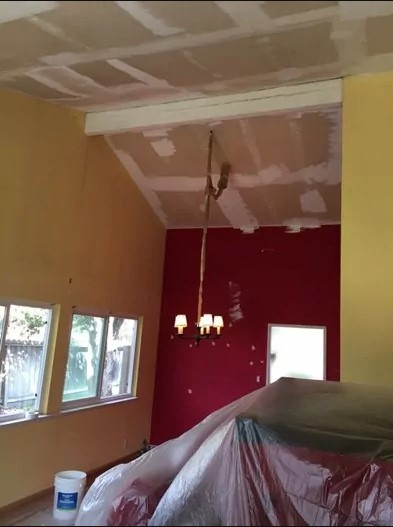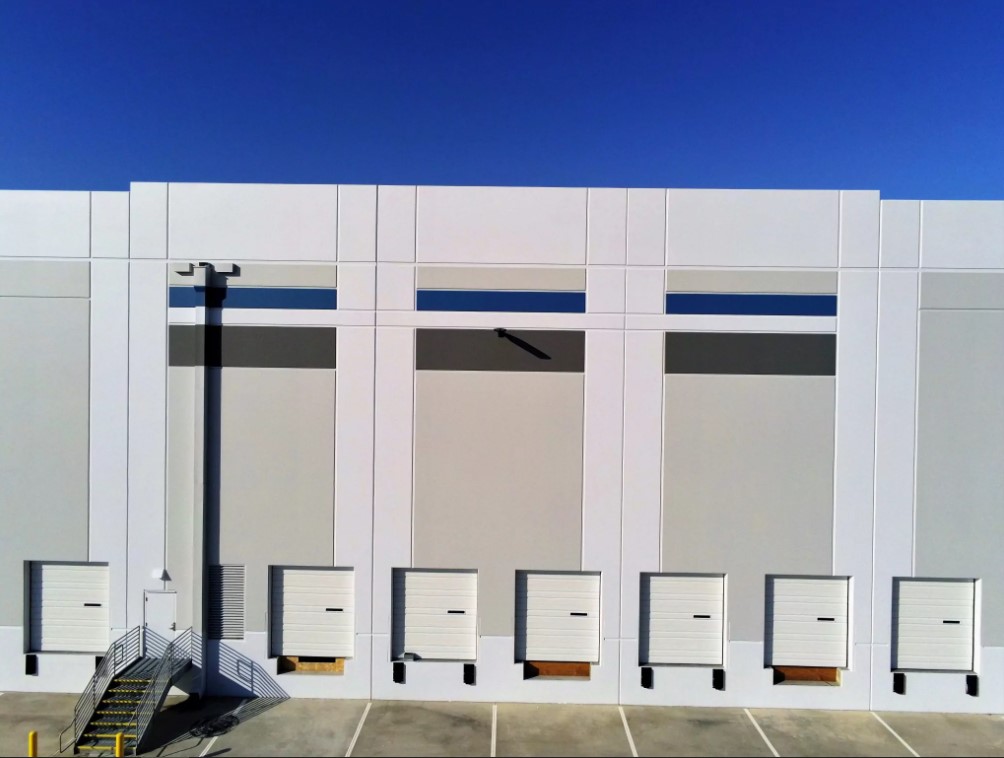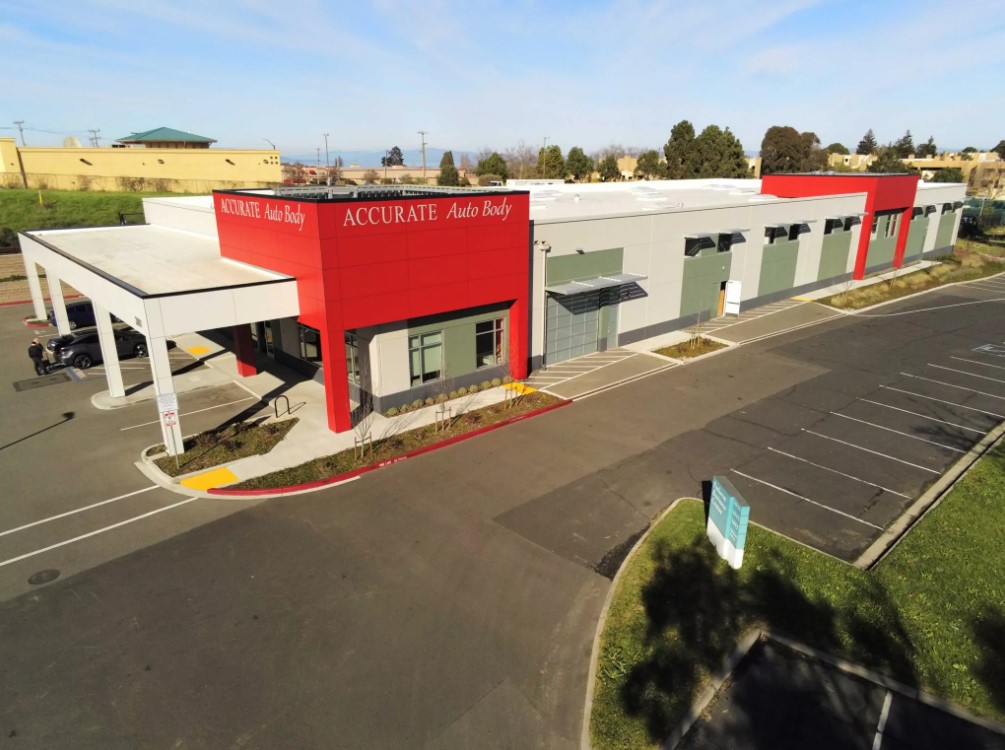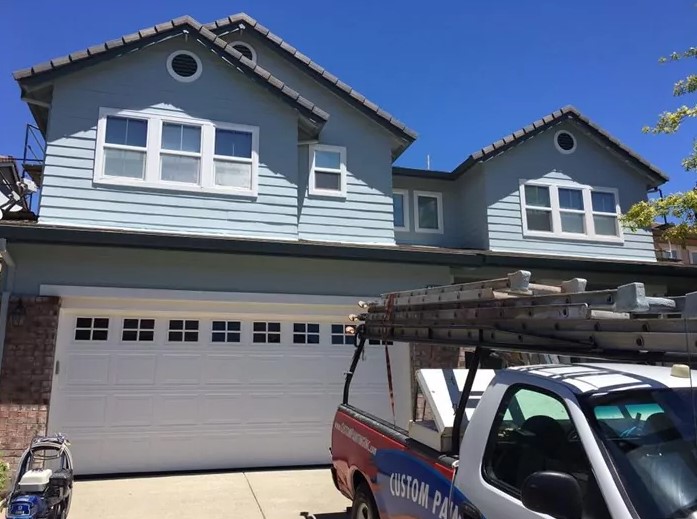You can dramatically improve your home’s appearance and atmosphere by painting it. Before beginning the process, a few things are important to understand, whether you will paint your home’s interior or exterior. Understanding these elements can help you create professional-looking results and ensure a positive painting experience, from proper preparation to color selection and application techniques.
The first step to any paint job is careful preparation. This includes preparing the surfaces to be painted, fixing any damage, and protecting adjacent furnishings and fixtures. Cleaning the surfaces ensures that paint adheres properly, and repairing cracks, holes, or peeling paint contributes to an even, smooth finish. Additionally, putting drop cloths or plastic sheets over furniture, floors, and other items stops unexpected spills or splatters, keeping your area tidy and safe while painting.
Choosing the appropriate paint colors is another important consideration. Spend time thinking about the general aesthetic and atmosphere you want to create. When selecting paint colors, take into consideration factors including natural lighting, existing design, and personal tastes. Before settling on a color, getting paint samples and trying them on the walls can be helpful. This lets you see how the coloring appears in various lighting situations and harmonizes with the adjacent elements.
Achieving professional results requires understanding suitable painting techniques. To get a smooth and uniform finish, methods like cutting in, which entails carefully painting along edges and corners and applying smooth and equal brush or roller strokes, are essential. Understanding the drying time and suggested number of applications for your chosen paint can also significantly impact the outcome. Additionally, purchasing high-quality paintbrushes, rollers, and other painting supplies can drastically speed up the process and produce better results.
So, what are you waiting for? Grab your brushes, open your mind to limitless possibilities, and enter the world of painting, where imagination has no bounds, and every brushstroke has the potential to produce something remarkable.
Reasons to Paint
1. Plans to sell the property and a desire to raise the resale value
The possibility of selling a home and increasing its resale value is essential when deciding whether to paint it. A property’s overall appeal and perceived worth can be improved by painting it before placing it on the market. Fresh paint can help give a place new life and increase its visual appeal to potential purchasers.
First impressions count, and a property’s condition is a significant factor in attracting potential buyers. Painting the external surfaces can considerably increase the property’s curb appeal. This will improve the chance of making a good first impression with potential purchasers. A property that is kept up well and looks well will probably make a good first impression on purchasers and may fetch a higher asking price.
A newly painted property also appears to have been well-maintained and cared for. It can convey to prospective purchasers that the house is in good shape, reducing their worries about unreported maintenance problems or repairs. This idea of a move-in-ready home can raise the perceived value and desirability of the property, increasing the likelihood that it will draw interested purchasers.
A well-chosen paint color scheme can enhance the property’s overall harmony and flow. Cohesive and elegant color schemes can visually connect the spaces, creating a homey and welcoming atmosphere. This focus on detail can significantly impact how potential buyers view the property’s overall quality and worth.
2. Improve the property’s curb appeal
Consider painting a property if you want to increase curb appeal. Curb appeal is the attractiveness and general appearance of any property from the street. Anyone selling their property wants to make a good first impression and lure potential customers or guests.
Homeowners can improve the curb appeal of a house by painting its outside surfaces. The property may start to look old and neglected due to the paint fading, peeling, or wearing over time due to exposure to the elements. The outside can be revitalized by adding a new coat of paint, giving it a maintained appearance.
When attempting to increase curb appeal, the paint color selection is crucial. Selecting a color harmonizes with the neighborhood while enhancing the property’s architectural style can greatly improve its aesthetic appeal. While more moderate and traditional tones can provide an exquisite and timeless look, bold and attention-grabbing colors can make a house stand out.
It’s essential to consider the paint job’s quality in addition to the color. A well-done paint job produces a clean and even surface, removing any noticeable brush strokes or irregularities. This level of care can improve the building’s overall appearance and increase its curb appeal.
A nicely painted exterior also conveys that the building has been well-maintained. It tells visitors and prospective buyers that the property is in good shape. It also shows the owners have put time and effort into maintaining it. Potential buyers may feel more confident and be more likely to view the property as a desirable alternative.
A home’s improved exterior appeal can also benefit the area and draw in possible purchasers. Properly well-kept and aesthetically pleasing properties enhance the neighborhood’s appeal and value, making the area a more desirable place to live for locals.
3. Ability to use better quality (low-VOC or zero-VOC) paints
Choosing superior paints, especially those that are zero- or low-VOC (volatile organic compound) in composition, is crucial when painting a home. Chemicals called VOCs, which are released by traditional paints, can be damaging to both human health and the environment. Choosing low- or zero-VOC paints has many advantages.
First off, occupant health is a top priority for low-VOC or zero-VOC paints. Compared to conventional paints, these paints have much lower concentrations of hazardous compounds. VOCs have been linked to respiratory problems, headaches, dizziness, and other health disorders due to the emission of harmful chemicals into the air. By selecting low-VOC or zero-VOC paints, you can improve the interior air quality, especially for people with allergies, asthma, or chemical sensitivities.
Additionally, using low- or zero-VOC paints shows concern for the environment. VOCs can harm ecosystems over the long run and contribute to air pollution. You can improve indoor and outdoor air quality, resulting in a healthier living environment for residents and the neighborhood, by lowering or eliminating VOC emissions.
Low-VOC or zero-VOC paints function similarly to traditional paints in terms of quality. They ensure a high-quality finish by providing exceptional coverage, durability, and color possibilities. You may now find the perfect colors and finishes to match your aesthetic tastes due to the broad selection of low-VOC or zero-VOC paint alternatives provided by many renowned paint brands.
Utilizing zero- or low-VOC paints shows your dedication to sustainability. These paints are produced using eco-friendly techniques and frequently have recycled materials. By selecting environmentally friendly paint solutions, you help to lessen the total environmental effect of paint manufacturing and disposal.
Additionally, using low-VOC or zero-VOC paints may be beneficial when renting or selling a house. The use of eco-friendly paints will be valued by prospective tenants or buyers who prioritize sustainability and good health. This eco-friendly decision may improve the property’s charm and market value.
4. New paint hides stains, mildew, and handprints
Painting a house is one way to cover handprints, mildew, and other blemishes adequately. Surfaces can develop a variety of stains and flaws over time, which can diminish a room’s overall aesthetic appeal. Painting is an effective way to cover up these flaws and regain a polished appearance quickly.
Water stains, for example, can be ugly and give the impression of neglect or damage to walls or ceilings. You can successfully hide these stains with a fresh coat of paint, creating a consistent and spotless surface. The new coat of paint serves as a barrier, hiding the stains underneath and improving the area’s appearance.
The growth of mildew and mold is a common problem in places with excessive humidity or poor ventilation. These can damage a property’s cleanliness and appearance by discoloring it and emitting bad scents. Before painting, it is crucial to care for these problems by meticulously cleaning and repairing the impacted areas. This helps to stop future growth and makes the environment clean and mold-free.
Walls frequently have handprints and smudges, especially in busy areas or houses with young children. While routine cleaning can help keep things tidy, some stains can occasionally be challenging to eradicate. The clean slate provided by painting over these handprints efficiently hides any traces of earlier smudges and leaves a smooth and perfect finish.
In addition to covering stains, mildew, and handprints, painting offers a chance to enhance the room’s general appeal. If you want a drastic change to the appearance of a room, a fresh coat of paint can drastically change the appearance and atmosphere of a room, whether you decide to continue with the current shade or choose something new and more contemporary. This revival can give the area new vitality and make it feel cozier and more visually appealing.
5. Protects the exterior surface (especially for commercial buildings)
Painting surfaces is a valuable form of protection, especially for commercial exteriors. Applying paint creates a shield that protects the underlying surface from outside factors and potential harm. Commercial buildings’ structural integrity and aesthetic value depend on this protective function.
Surface protection from abrasive weather is one of commercial painting’s main advantages as a preventative strategy. Frequent exposure to sunlight, rain, snow, wind, and other environmental conditions can cause the gradual deterioration of commercial exterior materials. Sunlight’s UV rays can cause fading and discoloration, while precipitation and moisture can cause rot, rust, and water damage. Applying high-quality paint designed exclusively for outside usage fortifies the surface against these factors and adds a layer of protection.
Additionally, paint protects surfaces from contaminants’ and pollutants’ negative impacts. The outside surfaces of buildings can become stained and degrade over time in metropolitan settings due to air pollution, industrial pollutants, and airborne particles. The integrity of the surface is preserved, and a cleaner appearance is maintained by keeping the exterior well-kept and routinely painted.
The painting also serves as a barrier against abrasion and wear. Commercial buildings’ exteriors are vulnerable to wear and tear from routine use, foot traffic, and the movement of tools and goods. As a shield, a durable paint covering lessens the effects of these regular actions and protects the underlying surface.
The type of paint used on commercial exteriors can greatly impact protection. The demands of commercial environments are carefully addressed in the formulation of high-quality exterior paints, which offer outstanding durability and resistance to fading, chipping, and peeling. To ensure the long-term integrity of the surface, they frequently integrate different protective qualities, including resistance to mold, mildew, and algae growth.
6. Creates a welcoming atmosphere for visitors to the property
Consider painting for the strong reason of making the house feel more welcoming to guests. Whether potential purchasers, clients, customers, or merely visitors, a property’s aesthetic design strongly affects the first impression it creates on visitors. Painting a property’s interior and exterior surfaces makes a difference when creating a cozy and welcoming atmosphere.
How a home’s exterior looks can influence how visitors feel once inside. An exterior that has been expertly painted conveys care and attention to detail immediately. The selection of paint colors and finishing touches can create a variety of feelings and tenors, including serenity, brightness, and refinement. You can design a visually appealing exterior that greets guests and invites them in by choosing color schemes and combinations that fit the desired mood.
The interior paint scheme is equally important in creating a pleasant atmosphere. Multiple colors can awaken particular feelings and establish the mood of a place. Warm and earthy colors, like soft yellows or warm neutrals, can create a friendly and welcoming atmosphere, whereas bold and colorful colors give a space life and personality. The proper color scheme can improve the aesthetics and functionality of various locations, such as lobby areas, waiting rooms, or communal areas, ensuring clients feel welcome and at ease.
The painted surfaces’ general condition and cleanliness, in addition to color, help to create an inviting environment. A well-maintained and well-cared-for property appears to have walls and ceilings that have just been painted. They might give off an air of professionalism, meticulousness, and dedication to creating a welcoming environment for guests. A neat and well-painted interior makes a good first impression and facilitates a pleasurable experience.
With the right paint job, home or business owners can also draw attention to specific architectural details, focal points, or significant sections of a site. Accent walls or artistic painting techniques can catch the eye and stimulate the senses. Through the addition of character and charm to the area, these design decisions help to create a welcoming atmosphere.
Property owners can provide visitors a pleasant and unforgettable experience by prioritizing a welcoming atmosphere through painting. A well-painted and welcoming environment may leave a lasting impression, increase customer happiness, and contribute to the property’s overall success, whether it is a residential building, commercial space, or hospitality institution.
7. Helps you stay within Homeowner Association (HOA) compliance
Maintaining Homeowner Association (HOA) compliance is a crucial responsibility for homeowners living in a community subject to specific rules and regulations. Maintaining a unified and consistent image throughout the neighborhood largely depends on painting your property’s exterior following HOA rules.
Regarding the paint colors, finishes, and even the application procedure for painting exteriors, HOAs frequently have specific rules and limits. These rules are in place to promote uniformity and preserve the neighborhood’s general aesthetic appeal. You support the community’s visual harmony and uniformity by following these rules.
It is essential to review the HOA rules before painting your house to learn about any limits or regulations. This could include rules about the kind of paint they can use, restrictions on daring or unconventional choices, or even specific color schemes. You can contribute to keeping the community’s preferred architectural style and aesthetic integrity by adhering to these rules.
Maintaining exterior painting within HOA guidelines also helps keep disputes and fines at bay. Warnings, penalties, or legal issues may result from violating HOA rules. You contribute to a friendly and peaceful living environment in the community by being familiar with and following the rules.
Additionally, adhering to HOA regulations for exterior painting might raise home values. A consistent and well-kept appearance throughout the neighborhood boosts the neighborhood’s appeal. Prospective tenants and buyers frequently prefer neighborhoods with well-run HOAs and unified aesthetics. You contribute to preserving and raising local property values by following the rules.
Paint Types
The majority of paints on hand are acrylic paints. They come in every glossy option and have excellent color retention and tensile strength. Additionally, there are epoxy paints, DTM (direct-to-metal) paints, and elastomeric paints.
1. Acrylic
Water-based acrylic paint has pigments suspended in an acrylic polymer emulsion. It’s renowned for its speedy drying time, adaptability, and capacity to produce a variety of textures. Because of its brilliant colors, durability, and simplicity of cleanup, acrylic paint is often the paint of choice by artists, DIY enthusiasts, and professionals.
2. Oil-based
Like mineral spirits or turpentine, a solvent is a foundation for oil-based paint. It is renowned for its toughness, long drying times, and rich, glossy finish. Oil-based paint is prized for its rich color palette, versatility in blending, and classic appearance. Fine art, furniture, trim work, and surfaces that need a durable and lustrous finish frequently utilize it.
3. Elastomeric
Elastomeric paint is a specific kind of exterior paint that contains elastic polymers, usually silicone or acrylic, that offer improved flexibility and durability. Extreme weather conditions, like heat, cold, and wetness, can not harm this paint. Elastomeric paint creates a thick, elastic layer that can span fractures and expand and contract with the substrate, making it ideal for surfaces like stucco, concrete, and masonry prone to cracking or movement.
4. Direct-to-metal
Without the use of a separate primer, direct-to-metal paint is designed to cling to metal surfaces directly. It is perfect for painting metal structures, machinery, and equipment because it offers good adhesion, corrosion resistance, and durability. Rust and other corrosion are generally protected from by DTM paints, which frequently include rust inhibitors.
5. Epoxy
Epoxy paint is a two-part solution that must be mixed before use. It has resin and a hardener. The epoxy paint hardens to a tough and long-lasting finish after being blended. Excellent adhesion, chemical resistance, and a high gloss finish are all characteristics of epoxy paint. It is frequently utilized on floors, counters, and surfaces that need to be durable and resistant to stains, impacts, and abrasion. To allow epoxy paint to be used for various purposes, it is offered in a range of formulas, including solvent-based and water-based choices.
These paint varieties have special qualities and benefits suited for diverse uses and surfaces. The desired finish, surface type, application technique, and environmental variables all play a role in selecting the best paint type.
Does Brand Matter?
Custom Painting, Inc. generally uses two brands of paint: Kelly-Moore and Sherwin-Williams. Cost is typically the most important issue since all commercially available paints are of a good caliber.
Many reliable paint brands are available for both residential and commercial purposes. The following well-known companies provide a selection of premium paints:
Kelly- Moore – A business called Kelly-Moore specializes in creating and dispensing paint goods. In San Carlos, California, Kelly-Moore Paints was established in 1946 and has become a well-known name in the paint industry. They provide various paint products, such as primers, stains, specialized coatings, and interior and exterior paints.
Sherwin-Williams – A well-known paint company with a large assortment of paints and varnishes is Sherwin-Williams. Including their famous labels like Duration, SuperPaint, and Emerald, they provide a wide selection of interior and outdoor paints. Sherwin-Williams’s paints are renowned for their coverage, color brightness, and durability.
Benjamin Moore – A reputable company, Benjamin Moore is renowned for its extensive selection of premium paints. They provide various interior and outdoor paints, including well-known lines like Advance, Regal Select, and Aura. Paints from Benjamin Moore are renowned for their remarkable color accuracy, toughness, and simplicity of use.
Behr – Popular paint company Behr offers a variety of colors appropriate for both home and business operations. They offer primers, specialized finishes, interior and exterior paints, and interior and exterior paints. Paints from Behr are renowned for their superior coverage, robustness, and affordability.
PPG Paints – PPG Paints is a well-known international paint brand that provides a wide selection of paints for both domestic and industrial purposes. In addition to their well-known labels, including PPG Timeless, PPG Diamond, and PPG ProLuxe, they provide a large selection of paints for the interior and exterior. PPG paints are renowned for their sturdiness, variety of colors, and superior finishes.
Dunn-Edwards – A prominent brand of regional paint in the western United States is Dunn-Edwards. They provide a variety of exterior and interior paints made for both domestic and industrial applications. Paints from Dunn-Edwards Paints are renowned for their durable construction, various colors, and eco-friendly compositions.
Valspar – A reputable paint company known for its extensive selection of paints and finishes is Valspar. For both home and commercial uses, they provide interior and exterior paints. Paints from Valspar are renowned for their superior finishes, longevity, and color accuracy.
Remembering preferences for paint can change depending on a person’s needs, a project’s specifications, and geographical availability is vital. Before choosing a paint brand, it is wise to get expert advice, check product reviews, and consider the needs of a particular project.
Where Paints Are Used
These are the most common uses of paints, but depending on the paint, it may be usable on other surfaces.
- Acrylic– Used on interiors and exteriors of homes
- Oil-based– Used primarily where oil-based paints have been used before
- Elastomeric– Used on interiors and exteriors of commercial buildings
- Direct-to-metal– Used on metal surfaces of interiors and exteriors
- Epoxy– Used chiefly on interior concrete floors
Paint Sheens and Why Use Them
Flat – Not durable, hard to clean – Use where they won’t require frequent cleaning – bedrooms, ceilings
A low or non-reflective finish is referred to as being “flat” in terms of paint shine. It is also occasionally referred to as matte or eggshell. Flat paint seems velvety and smooth with little sheen or glossiness.
Many different applications use flat paint sheen for the following reasons:
- Hiding Imperfections – Flat paint is good at hiding surface flaws such as tiny cracks, dents, or patches. It is the perfect solution for uneven or textured surfaces because of its low, reflecting qualities, which reduce the visibility of faults.
- Even Color Distribution– Flat paint tends to disperse color evenly over a surface, giving it a uniform look. This helps avoid streaking or uneven spots, especially when dealing with deeper or stronger colors.
- Soft and Subtle Look– Flat paint offers a softer, more understated look than higher gloss sheens. It gives walls a smooth, inconspicuous appearance that makes other aspects of the room, like furniture or artwork, the focal point.
- Reduced Glare– Flat paint reduces glare and eye strain by absorbing light rather than reflecting it. As a result, flat paint is frequently used for spaces with intense natural or artificial illumination, such as bedrooms, living rooms, or workplaces, where a more calming and relaxing atmosphere is needed.
- Touch-Up Friendly– Flat paint is frequently more forgiving when it comes to touch-ups. Its non-reflective properties allow it to minimize noticeable differences by blending new paint with the previously painted surface. This simplifies covering for little defects or repairs without completely repainting the area.
Eggshell – More durable, can be cleaned – Use in living rooms, hallways, guest bathrooms
On the gloss scale, “eggshell” is a paint sheen that lies between flat/matte and satin finishes. Its name comes from the subtle shine that gives it the appearance of an eggshell. Eggshell sheen is a popular option for many applications because it strikes a mix between strength and delicate gloss.
The following justifies the wide availability of eggshell paint sheen:
- Subtle Sheen– Eggshell sheen gives painted surfaces a gentle, subtle shimmer. While less reflecting than higher gloss sheens, it offers a subtle shimmer that is more noticeable than flat/matte finishes. Walls and other painted surfaces gain a warm, inviting appearance from the addition of this subtle sheen, which gives them a touch of refinement and depth.
- Easy Maintenance– Compared to flat/matte sheens, eggshell finishes are typically easier to clean and maintain. The surface can better resist stains and markings because of its mild smoothness. It is appropriate for moderately high-traffic areas like living rooms, corridors, and bedrooms since it can endure light scrubbing and cleaning without immediately displaying indications of damage or wear.
- Hides Minor Imperfections– Eggshell sheen can nevertheless aid in concealing minor flaws on the painted surface, although not as effective as flat/matte finishes. You can make minor dents, lumps, and abnormalities in the texture of walls appear less noticeable, giving the surface a more uniform and appealing appearance.
- Versatility– Eggshell shine is adaptable and may be used in a variety of areas, including both domestic and professional settings. Its mild brilliance complements a variety of interior design aesthetics and gives designers some design versatility. It can add a slight sheen that improves a room’s overall visual appeal while blending in with modern and traditional styles.
- Reflects Light– Eggshell shine reflects some light, which can help make a room appear brighter. Diffusing light, primarily when used in conjunction with strategically positioned lighting sources, may give a space a more open and breezy effect. This makes it a fantastic option for rooms with little natural light or for people who want to make their surroundings brighter.
Satin – More durable, can be cleaned – Use in high-traffic areas like kitchens, laundry rooms, playrooms
On the gloss scale, “satin” is a paint sheen that is between eggshell and semi-gloss finishes. It looks silky and smooth and has a delicate sheen. Satin sheen is a popular option for many applications because it strikes a mix between toughness, simplicity of maintenance, and a soft gloss.
These justifications for the widespread use of satin paint sheen:
- Attractive Appearance– Painted surfaces have a smooth and sophisticated appearance because of the satin gloss. It provides a soft glow that adds depth and richness to a room’s overall appeal. Colors may appear more vivid due to the modest sheen of satin paint, which also gives a room a polished and upscale appearance.
- Durability and Easy Maintenance– Compared to eggshell or flat/matte finishes, satin finishes are more robust and resistant to wear and tear. The little higher gloss level offers improved defense against blemishes, scratches, and mildew. Satin sheen is ideal for high-traffic areas like kitchens, bathrooms, and corridors since it is simple to maintain and can endure light scrubbing without quickly revealing signs of wear.
- Versatility– The use of satin sheen is flexible and suitable for both domestic and business contexts. Its moderate shine level blends well with both traditional and contemporary design aesthetics. Because satin paint offers a modest contrast while retaining a uniform appearance throughout the room, it is frequently chosen for walls, trim, and doors.
- Reflects Light– Compared to eggshell, satin sheen reflects more light, making a space appear lighter and more lively. It helps to reflect light throughout the area, giving an impression of a bigger, more open space. This might be especially useful in rooms with little natural light or for people who want to create a dynamic and welcoming atmosphere.
- Easy Application– Satin paint covers well and is comparatively simple to use. Compared to higher gloss finishes, it often requires fewer applications, saving time and effort during painting. Satin paint is appropriate for professional and DIY projects because it is forgiving and smooth.
Semi-gloss – More durable, with some shine, easy to clean – Use for trim, railings, and cabinets
On the gloss scale, “semi-gloss” refers to a paint sheen that lies between satin and high-gloss finishes. It gives a sense of refinement to painted surfaces with its unmistakable sheen and reflecting surface. A semi-gloss sheen is a popular option for many applications since it has several advantages.
The following justifies the widespread use of semi-gloss paint sheen:
- High Durability– Semi-gloss finishes are ideal for places with considerably more traffic or need frequent cleaning since they are quite strong and resistant to wear. Semi-gloss paint’s glossy, smooth surface helps to shield it from scratches, scuffs, and stains. It is frequently applied to trim, doors, cabinets, and other high-traffic areas.
- Easy to Clean– Semi-gloss paint is easy to clean and maintain due to its glossy surface. It resists dirt and stains, making cleanup with mild soap and water and simple wiping possible. This makes it a well-liked option for damp locations requiring frequent cleanings, such as kitchens and bathrooms.
- Reflects Light– Semi-gloss sheen reflects much light, illuminating a room and producing an attractive visual impact. It makes a space seem more extensive, more airy, and well-lit. Semi-gloss paint is particularly well suited for rooms with little natural light because of its reflecting qualities.
- Enhances Details– Semi-gloss sheen highlights molding, trim work, and architectural elements. It gives a place a clean, polished appearance that adds a hint of refinement to the entire design. These components can be made to stand out using semi-gloss paint, creating a beautiful contrast with the nearby surfaces.
- Moisture Resistance– Semi-gloss paint is appropriate for areas subject to splashes or steam since it has good resistance to moisture and humidity. Its glossy surface deflects water, shielding the painted surface from harm and reducing water damage. It is frequently utilized in laundries, kitchens, and toilets.
- Easy Application– Semi-gloss paint offers good coverage and is similarly pretty simple to apply to satin paint. Compared to high-gloss finishes, it often requires fewer coats, saving time and energy while painting—the smooth texture of semi-gloss paint aids in producing a consistent and expert-looking finish.
High-gloss – Most durable, very easy to clean – Use for trim, railings, cabinets, and accent walls. Be careful when applying because it shows flaws.
The highest sheen of shine offered in paints is “high-gloss.” It provides a shiny, reflective surface that gives painted surfaces a posh, polished appearance. A high-gloss sheen is a popular option for particular applications because it has distinctive advantages.
The following justifies the widespread use of high-gloss paint sheen:
- Maximum Durability– High-gloss coatings have exceptional tensile strength and abrasion resistance. High-gloss paint is appropriate for places that see a lot of activity or need frequent cleaning because of its tough, glossy finish, which can endure severe use. It is frequently applied to surfaces that need extra protection, such as doors, trim, cabinets, and windows.
- Enhanced Light Reflection– Out of all paint sheens, high-gloss sheen produces the brightest and most reflective surface. As a result, it’s an excellent option for places that need the most light to reflect, such as small rooms, obscure corners, or areas with little natural light. High-gloss paint’s reflecting qualities can help a room look bigger and more airy.
- Easy to Clean– High-gloss paint has a smooth, impervious surface that is highly stain, moisture, and dirt resistant. It is simple to clean because most substances can be removed with a moist cloth or light cleaning agent. This makes high-gloss shine a well-liked option for spaces like kitchens, bathrooms, and corridors prone to spills or needing frequent cleaning.
- Highlighting Details– Highlighting architectural features, trim work, and molding is a specialty of high-gloss coatings. These characteristics are highlighted by the shiny surface, which stands out sharply from the nearby surfaces. High-gloss paint can bring out subtle patterns and ornamental accents, giving a room a touch of class and sophistication.
- Reflective Decor– High-gloss paint’s high reflectivity can improve the appearance of ornamental items in a room. It can enhance and magnify the artwork’s beauty, mirrors, and other things, giving the whole design a sense of depth and visual interest.
- Modern and Dramatic Look– High-gloss sheen is frequently linked to a contemporary, sleek, and expensive look. It offers a rich, glossy look that oozes luxury. High-gloss paint is a popular option for modern and minimalist designs because of its bold and shiny appearance, which may have a dramatic visual effect.
Things to Consider When Hiring Painters
- How long have they been in business?– One crucial consideration when considering hiring painters for your project is how long they have been in operation. A painting company’s time in business might reveal essential details about their expertise, dependability, and general experience.
- Do they have a license?– Whether painters have a license is essential when hiring them for your project. A license is a formal document issued by a governing body that certifies the painters have satisfied specific conditions and are legitimately permitted to work in their particular location.
- Are they insured and bonded?– Determining if painters have insurance and bonds is crucial before considering hiring them for your project. Insurance and bonding are essential components that protect you as the client and those doing the painting.
- Do they have employees or contractors on their team?– It’s essential to find out if the painters you’re thinking about hiring for your job are employees or independent contractors. Knowing how their team is made up can help one understand their workforce’s dynamics, responsibility, and consistency.
- Do they provide a written estimate and warranty?– It’s necessary to consider whether painters offer a documented estimate and warranty before choosing them for your project. These two elements are essential for establishing expectations, guaranteeing openness, and protecting your interests as a client.
- Will they provide names and contact information for past clients?– It’s crucial to ask painters whether they are ready to supply names and contact details of previous clientele when considering hiring them for your job. This factor is crucial for learning about the reputation, caliber of work, and client happiness of the painters.
Time is the main advantage of hiring a professional painter! Hiring a professional painter will save you lots of time. A painting crew can accomplish the task in a few days, taking an untrained homeowner or business owner a week or more.
Conclusion
You may significantly improve your painting experience and guarantee excellent outcomes by being aware of the numerous painting aspects. You may make informed judgments and accomplish the intended result for your home or commercial project by considering the reasons to paint, various paint types, sheens, and hiring concerns. Having information about painting enables you to make well-informed decisions and work effectively with painters to realize your vision, whether you want to improve the beauty of your house or business, boost its worth, or protect surfaces. Spend some time learning about painting methods, supplies, and hiring criteria so that you can start your painting career with assurance and success.



